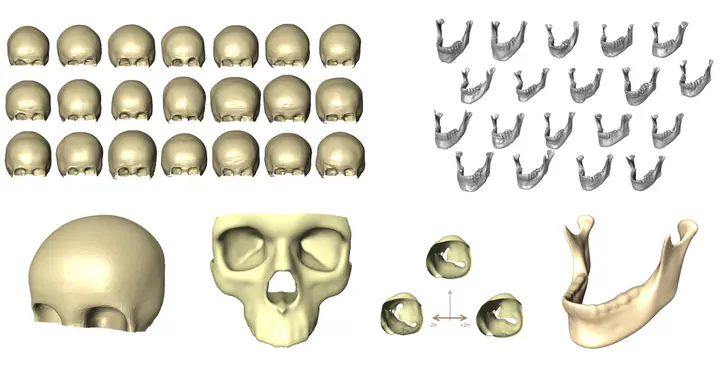
Abstract
In our chapter we are describing how to reconstruct three-dimensional anatomy from medical image data and how to build Statistical 3D Shape Models out of many such reconstructions yielding a new kind of anatomy that not only allows quantitative analysis of anatomical variation but also a visual exploration and educational visualization. Future digital anatomy atlases will not only show a static (average) anatomy but also its normal or pathological variation in three or even four dimensions, hence, illustrating growth and/or disease progression.
Statistical Shape Models (SSMs) are geometric models that describe a collection of semantically similar objects in a very compact way. SSMs represent an average shape of many three-dimensional objects as well as their variation in shape. The creation of SSMs requires a correspondence mapping, which can be achieved e.g. by parameterization with a respective sampling. If a corresponding parameterization over all shapes can be established, variation between individual shape characteristics can be mathematically investigated.
We will explain what Statistical Shape Models are and how they are constructed. Extensions of Statistical Shape Models will be motivated for articulated coupled structures. In addition to shape also the appearance of objects will be integrated into the concept. Appearance is a visual feature independent of shape that depends on observers or imaging techniques. Typical appearances are for instance the color and intensity of a visual surface of an object under particular lighting conditions, or measurements of material properties with computed tomography (CT) or magnetic resonance imaging (MRI). A combination of (articulated) Statistical Shape Models with statistical models of appearance lead to articulated Statistical Shape and Appearance Models (a-SSAMs).
After giving various examples of SSMs for human organs, skeletal structures, faces, and bodies, we will shortly describe clinical applications where such models have been successfully employed. Statistical Shape Models are the foundation for the analysis of anatomical cohort data, where characteristic shapes are correlated to demographic or epidemiologic data. SSMs consisting of several thousands of objects offer, in combination with statistical methods or machine learning techniques, the possibility to identify characteristic clusters, thus being the foundation for advanced diagnostic disease scoring.